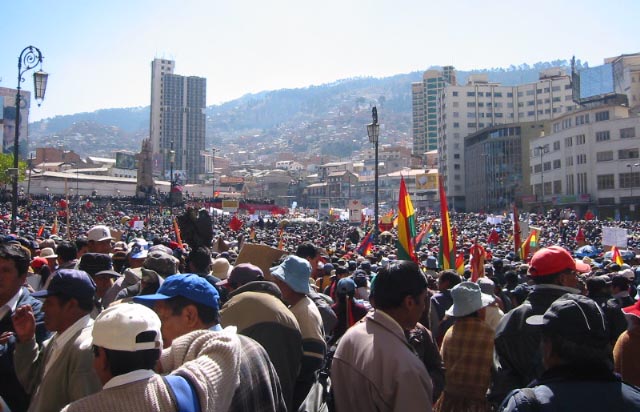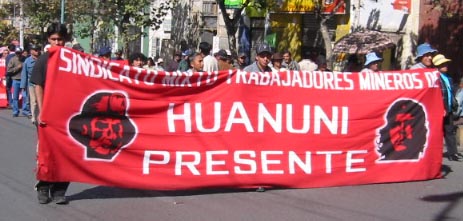
June 2005
Bolivian Capital Shut Down by Mass
Protests

Tens of
thousands of Bolivian
workers, peasants and poor people converge on Plaza San Francisco in
the capital, La Paz, calling to shut down the corrupt parliament and
nationalize gas and oil resources.
(Internationalist
photo)
FLASH – 10 p.m. – Bolivian
President
Carlos Mesa just submitted his resignation in the face of mass
protests. Who
will succeed him is an open question, supposedly to be resolved
tomorrow by the
Bolivian Congress. Mesa “governed” for 19 months after taking over from
the
previous president, Gonzalo Sánchez de Lozada. That mass
murderer was driven
out by a workers uprising against the bloody repression he
unleashed attempting to crush protests against his deals with a
“multinational”
gas cartel. Since then the political, social and economic crisis has
only
escalated. Today a huge march of workers, peasants and slum dwellers
occupied
the center of the capital, already cut off by road blockades that have
shut
access to the city. Mesa’s resignation is a demonstration of the
incapacity of
Bolivia’s ruling class to resolve the basic problems facing this
impoverished
Andean country. If the rightist head of Congress is named his
successor, mass
outrage will escalate further. The threat of a military coup is real.
The only
solution: ¡Obreros al poder – Workers
to power!
LA PAZ, JUNE 6 – Al parlamento hay que
cerrarlo, a
los corruptos hay que colgarlos: “We have to close down parliament
and hang
those crooks,” Aymara Indians sang in today’s enormous demonstration.
Theirs
was one of the seemingly endless columns of marchers pouring down from
the
slums of El Alto into the center of the Bolivian capital. Mesa y
Goni, el
mismo engaño, leyes malditos han firmado, they continued, to
the tune of an
Andean huayño: “Mesa and Goni, the same trickery,
signing accursed
laws.” Carlos Mesa, the current president, is the successor to Gonzalo
Sánchez
de Lozada (“Goni”), who unleashed massive repression in a failed
attempt to
crush the upheaval of October 2003.
The Plaza San Francisco in central La Paz
overflowed today with angry workers, peasants and slum dwellers. “Mass
marches
and dynamite explosions rocked the capital,” reported the radio. Miners
and
factory workers joined peasants from the altiplano
(highlands) and the Yungas below La Paz, teachers, organizations of the
unemployed and many tens of thousands of others demanding
“Nationalization of
gas and oil.”
“No autonomy for the oligarchy of Santa
Cruz,” demanded the marchers, enraged at Mesa’s agreeing to the
“autonomy”
referendum extorted by the elite of that lowland eastern department
(province),
together with that of other gas-rich regions, as a weapon against the
western
Indian highlands. A placard denounced the Santa Cruz upper crust as
“remnants
of Pizarro,” the Spanish conquistador of the Andes who is a fitting
symbol of
the centuries of pillage that have left the overwhelming majority of
the
Bolivian population mired in the deepest poverty.
The marchers’ mood was radical and angry.
Hundreds
of demonstrators carried signs denouncing the ruling class in the most
explicit
terms: Burgueses, los días son contados – Capitalists,
your days are
numbered. “Death to the Bolivian bourgeoisie,” “We’ve had it with
bourgeois
parliamentary maneuvers,” read hand-lettered signs.
Class outrage boiled over, as Indian women
yelled at
well-dressed passersby to take off their neckties. Armed with sticks,
some of
them with nails protruding, women in traditional aguayo shawls
and pollera
petticoats forced shops and street peddlers to close down. In the
wealthy
neighborhoods of southern La Paz, normally arrogant members of the
upper crust
literally cower behind their metal gates.
Smoke from burning tires mixed with the
teargas fired
by riot police against demonstrators who tried once again to take the
Plaza
Murillo, seat of the national government. The city is running out of
fuel as a
result of the road blockades by peasant and labor organizations
throughout the
country.
The Catholic Church is demanding an end to
mobilizations as part of the “dialogue” it is frantically seeking. In
their
attempts to “mediate” an end to the bitter class struggle that has
brought this
country to a virtual standstill over the recent weeks of protest,
Church
leaders met today with Evo Morales, leader of the Movimiento al
Socialismo
(MAS). Morales has been a key prop of Mesa’s increasingly isolated
government.
Today, the MAS leader spread more illusions in the Bolivian Parliament,
calling
on it to “completely recover” the country’s oil and gas reserves
through an
amended energy law (see “Bolivia Explodes in Sharp Class Battle,” June
1).
 Miners from
the historically militant Huanuni tin mine march La Paz June 6.
Miners from
the historically militant Huanuni tin mine march La Paz June 6. (Intrernationalist photo)
Yet the contempt for the bourgeois Congress
angrily
expressed by the marchers who brought La Paz to a halt today reflects
widespread disgust not only with Goni’s allies who control parliament,
but
increasingly with the institution itself. In today’s demonstration,
calls for
nationalization were much more common than slogans for the “constituent
assembly” Morales has demanded and Mesa has agreed to call in new
maneuvers
aimed at ending the mass mobilizations.
But bourgeois nationalizations are not enough
to
free the exploited from centuries of poverty. Expropriation of the gas
and oil
“multinationals,” without compensation, must be brought about by the
action of
the working class seizing the installations in the fight for a
revolution that
puts power in the hands of the exploited themselves, a socialist
revolution.
Already, protesters have seized two oil wells
in
Camiri, a city in eastern Bolivia best known of the site of the
military trial
of associates of Che Guevara’s guerrilla group in 1967. Today, the
Transredes
oil facility, which ships 150,000 barrels per day, was occupied by
protesters.
Earlier the refinery in Cochabamba was occupied by workers. Outside La
Paz,
peasants cut off the river that supplies water to the capital.
Rumors escalate that the president may call
out the
army for massive repression, or that the armed forces may take matters
into
their own hands. Sticks of wood, even sticks of dynamite, are far from
sufficient to defend the working people against this threat. In the
Plaza San
Francisco today, a retired miner from Catavi-Siglo XX bought the new El Internacionalista pamphlet on Bolivia
and told us, “The working class here used to be armed. The one who put
an end
to that was General Barrientos,” who led a military coup in 1964 and
used
populist demagogy, including speeches in Quechua in which he proclaimed
a
“military-peasant alliance” – against the workers.
The need for self-defense groups, nuclei of
workers
and peasants militias, is palpable. Together with workers and peasants
councils
like the soviets of the Russian Revolution, they can win over the
plebeian
ranks of the army, against the
officer corps which has carried out unnumbered massacres against
miners,
factory workers, peasants and students. Yet leading sectors of the COB
(Bolivian Labor Federation), including its general secretary Jaime
Solares,
continue appealing to nationalist officers.
Today’s mass meeting voted resolutions for
nationalization of oil and gas and the seizure of the oil fields and
gas wells,
and for a “People’s and Indian Government,” a populist formula which
very
deliberately seeks to appeal to sectors of the bourgeoisie and armed
forces.
This is a formula for defeat. The League for the Fourth International,
in
contrast, calls for a workers, peasants and Indians government to
carry
out socialist revolution to bring down the bloody rule of the
bourgeoisie.
Immediately posed is the formation of workers, peasants and soldiers
councils
on which such a revolutionary government would be based.
Only the class
power of the proletariat, gathering all the exploited and oppressed
around the
banner of workers revolution, shows a way out. The absence of a
genuinely
revolutionary party – the crisis of proletarian leadership – is the
only reason
the Bolivian bourgeoisie has not been swept away, as thousands of
marchers
demanded today.
In the Plaza San Francisco, dozens of workers
and
Indian peasants told us of their anger and their hopes today and
listened with
passionate interest when we said how revolution in Bolivia could set
the region
aflame and win support from workers across the borders and across the
world.
“The burgueses keep us in hunger,”
“They have stolen everything all the way back to the days of silver,”
“We need
to throw them out,” demonstrators said. A party like the Bolsheviks of
Lenin
and Trotsky must be forged to lead this struggle.
Mobilizations are to continue tomorrow, as the bourgeois Congress is scheduled to convene. n
To contact the Internationalist Group and the League for the Fourth International, send e-mail to: internationalistgroup@msn.com